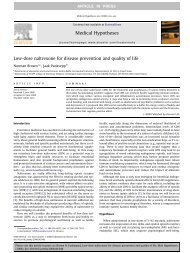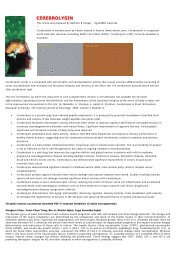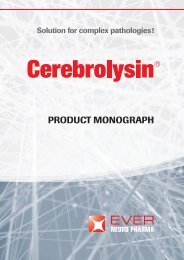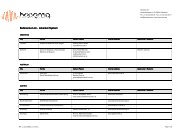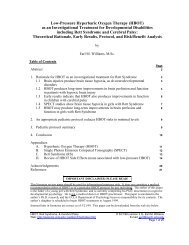Textbook of Hyperbaric Medicine - HyperMED
Textbook of Hyperbaric Medicine - HyperMED
Textbook of Hyperbaric Medicine - HyperMED
You also want an ePaper? Increase the reach of your titles
YUMPU automatically turns print PDFs into web optimized ePapers that Google loves.
236 Chapter 19<br />
Introduction<br />
For a discussion <strong>of</strong> the effectiveness <strong>of</strong> hyperbaric oxygen<br />
(HBO) therapy in global cerebral ischemia/anoxia and coma,<br />
we define HBO as a medical treatment that uses high<br />
pressure oxygen as a drug by fully enclosing a person or<br />
animal in a pressure vessel and then adjusting the dose <strong>of</strong><br />
the drug to treat pathophysiologic processes <strong>of</strong> the diseases.<br />
Like all drugs, the dose <strong>of</strong> HBO is crucial and should be<br />
customized to each patient’s response. It is dictated by the<br />
pathological target and is determined by the pressure <strong>of</strong><br />
oxygen, duration <strong>of</strong> exposure, frequency, total number <strong>of</strong><br />
treatments, and timing <strong>of</strong> the dose in the course <strong>of</strong> the disease.<br />
As diseases and their pathologies evolve, different doses<br />
<strong>of</strong> HBO are required at different times. In addition, patients<br />
have individual susceptibility to drugs, manifest sideeffects<br />
and toxicity. Unfortunately, the ideal dose <strong>of</strong> HBO<br />
in acute or chronic global ischemia/anoxia and coma is unknown.<br />
The studies reviewed below suggest higher pressures<br />
(2 ATA or higher) and lesser numbers <strong>of</strong> treatments<br />
very early in the disease process whereas lower pressures<br />
(2 ATA or lower) and a greater number <strong>of</strong> treatments have<br />
been used as the brain injury matures. While this general<br />
trend seems justified, the absolute or effective pressures delivered<br />
to the patients in these reports may be slightly less<br />
than what is stated since many studies do not specify the<br />
HBO delivery system that was employed. For example, an<br />
oxygen pressurized chamber has an effective HBO pressure<br />
equal to the plateau pressure administered during the treatment,<br />
whereas an air pressurized chamber in which oxygen<br />
is administered by aviators mask can achieve a far lower<br />
effective HBO pressure, depending on the fit <strong>of</strong> the mask<br />
and the amount <strong>of</strong> its air/oxygen leak. In the later cases, the<br />
dose <strong>of</strong> oxygen is less. This concept is particularly important<br />
when analyzing the studies in this chapter performed<br />
prior to the late 1980s when the aviator mask dominated<br />
delivery systems in multiplace chambers.<br />
In reviewing the data in this chapter, it is surprising that<br />
HBO has not enjoyed widespread use for neurological diseases<br />
in the United States. This has been partly due to institutional<br />
reservations and overt therapeutic nihilism for<br />
neurological injuries, both <strong>of</strong> which are presently waning.<br />
To assume that HBO could have efficacy and benefit when<br />
liberally applied to various “accepted” indications, yet have<br />
none in the great majority <strong>of</strong> neurological conditions is<br />
perplexing. After all, the brain is enclosed within the same<br />
body in the same pressure vessel and is exposed to the same<br />
elevated oxygen pressure. To justify this distinction, one<br />
would have to postulate that an entire set <strong>of</strong> pathophysiological<br />
processes <strong>of</strong> brain that are insensitive to HBO and<br />
distinct from those in the rest <strong>of</strong> the body’s organ systems<br />
which are sensitive to HBO and to which we routinely apply<br />
HBO. This is illogical and unlikely. Such reasoning is<br />
indefensible when one considers the “accepted” neurological<br />
indications include carbon monoxide poisoning, brain<br />
decompression sickness, cerebral air embolism, brain abscess,<br />
and cyanide poisoning. We conclude that HBO<br />
should benefit other hypoxic/ischemic conditions <strong>of</strong> the<br />
brain, provided the dose is correct, i.e., target specific.<br />
Other reasons for nonrecognition <strong>of</strong> HBO in neurological<br />
conditions concern methodologies. The standard for<br />
pro<strong>of</strong> in scientific medicine has been the randomized prospective<br />
controlled double-blinded clinical trial. While<br />
some <strong>of</strong> the studies in this chapter meet this rigor (except<br />
for double-blinding), many do not. Some are randomized,<br />
prospective, and controlled and thus exceed the quality <strong>of</strong><br />
studies used to sanction reimbursement for some HBO indications.<br />
Other studies are uncontrolled series, case-controlled,<br />
or individual cases. All <strong>of</strong> this clinical data, in conjunction<br />
with the animal data, makes a strong case for at<br />
least attempting HBO in what are otherwise untreatable<br />
conditions with debilitating, tragic, and expensive outcomes,<br />
especially when the visual medium is used to prove<br />
single-case causality (Kiene & von Schön-Angerer 1998;<br />
Harch 1996). In addition, case-controlled series with<br />
chronic neurological maladies make powerful statements<br />
<strong>of</strong> efficacy from the statistical (Glantz 1992) and logical<br />
perspectives where the counterargument <strong>of</strong> placebo effect<br />
is minimized (Kienle & Kiene 1996). If these considerations<br />
are kept in mind when analyzing this chapter, it appears<br />
that the bulk <strong>of</strong> data is solidly in favor <strong>of</strong> a beneficial effect<br />
<strong>of</strong> HBO in global ischemia/anoxia and coma.<br />
Pathophysiology<br />
The effect <strong>of</strong> global ischemia/hypoxia on the brain has been<br />
discussed in Chapter 5. Oxidation <strong>of</strong> glucose is the primary<br />
energy source for the brain. Deprivation <strong>of</strong> oxygen causes<br />
deep psychological unresponsiveness in 8 s while glucose<br />
and energy stores take a few minutes to exhaust (Plum &<br />
Pulsinelli 1992). Global deprivation <strong>of</strong> oxygen delivery can<br />
be achieved by reduction in blood flow (ischemia), oxygen<br />
(hypoxia/anoxia), or both (hypoxic or anoxic ischemia).<br />
Unfortunately, clinical syndromes and animal models are<br />
rarely pure and <strong>of</strong>ten result from combinations or sequences<br />
and varying degrees and durations <strong>of</strong> hypoxia/anoxia<br />
and ischemia. Since the insult, oxygen deprivation, is similar<br />
whether by lowered blood flow or oxygen content the<br />
two are <strong>of</strong>ten considered as a single type <strong>of</strong> insult and this<br />
concept will be followed in this chapter.<br />
Global ischemia/anoxia is a severe transient insult to the<br />
brain that causes a stereotypic pathophysiology characterized<br />
by reperfusion hyperemia followed by progressive<br />
ischemia which is <strong>of</strong>ten heterogeneous (Safar 1986; Dirnagl<br />
1993). The extent <strong>of</strong> injury is governed by a complex interplay<br />
<strong>of</strong> patterns <strong>of</strong> systemic and local respiratory and circulatory<br />
function and selective vulnerability <strong>of</strong> cells (Mey-




